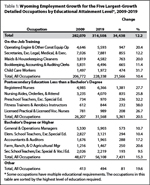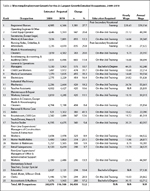Occupational Projections: Most Jobs Require On-the-Job Training
Wyoming is projected to add a net 34,438 jobs from 2009 to 2019. The articles in this issue examine where those jobs will be found at the occupation and industry levels. Also, as workers leave Wyoming's labor market, their departure will create employment opportunities in the state (see related article).
In 2009, occupations requiring on-the-job training accounted for 73.3% of all jobs in Wyoming. This is expected to continue over the next 10 years. By 2019, Wyoming is projected to add a net 34,438 jobs, growing from 282,070 to 316,508 (12.2%). In 2019, an estimated 72.1% of all jobs in Wyoming will require on-the-job training. 
Of the 34,438 projected new jobs, 62.6% will require on-the-job training. These types of job do not require any sort of postsecondary education, such as vocational education or a bachelor's degree. Occupations requiring on-the-job training will grow by 21,566, or 10.4% (see Table 1).
Occupations requiring a bachelor's degree or higher accounted for 17.3% of all occupations in Wyoming in 2009 and are expected to make up a similar percentage (17.7%) in 2019. These types of occupations are projected to grow from 48,677 to 56,108 (7,431, or 15.3%) during this period.
Occupations requiring postsecondary education less than a bachelor's degree – such as an associate's degree or vocational education – made up 9.3% of all of Wyoming's occupations in 2009; these types of occupations are expected to account for a slightly higher percentage (10.0%) in 2019. According to the projections, Wyoming will add 5,361 of these types of jobs during this 10-year period, the highest percentage growth (20.5%) of all levels of educational attainment.
 Among the 25 occupations with the largest growth from 2009 to 2019, 20 require on-the-job training (see Table 2). The largest growth among these types of occupations will be seen in operating engineers & other construction equipment operators (947, or 20.4%); secretaries, except legal, medical, & executive (855, or 12.2%); and maids & housekeeping cleaners (763, or 20.0%).
Among the 25 occupations with the largest growth from 2009 to 2019, 20 require on-the-job training (see Table 2). The largest growth among these types of occupations will be seen in operating engineers & other construction equipment operators (947, or 20.4%); secretaries, except legal, medical, & executive (855, or 12.2%); and maids & housekeeping cleaners (763, or 20.0%).
Only 3 of the top 25 occupations with the largest growth require bachelor's degrees: general & operations managers (573, 10.7%); elementary school teachers, except special education (294, or 10.4%); & accountants and auditors (288, or 17.2%). Only 2 of these 25 occupations require postsecondary education less than a bachelor's degree: registered nurses (1,381, or 27.7%) and nursing aides, orderlies, & attendants (835, or 25.8%).
Some occupations are projected to shrink during this period (see Table 3). All of the top 10 occupations projected to see the highest level of job loss  require on-the-job training. Three of these occupations are directly tied to the U.S. postal service: postal service mail carriers, postal service mail sorters, processor, & processing machine sorters, and postal service clerks. These three occupations are projected to lose a combined 274 jobs in Wyoming.
require on-the-job training. Three of these occupations are directly tied to the U.S. postal service: postal service mail carriers, postal service mail sorters, processor, & processing machine sorters, and postal service clerks. These three occupations are projected to lose a combined 274 jobs in Wyoming.
Levels of Education
Table 4 shows that among the top 10 occupations requiring on-the-job training projected to see the largest amount of growth, 4 have average  annual wages under $30,000: secretaries, except legal, medical, & executive ($29,245); maids & housekeeping cleaners ($20,197); child care workers ($22,214); and teacher assistants ($23,859). Many of the higher paying jobs in this group of occupations are related to the construction and natural resources & mining industries, including operating engineers & other construction equipment operators ($48,087); electricians ($51,626); and industrial machinery mechanics ($55,661).
annual wages under $30,000: secretaries, except legal, medical, & executive ($29,245); maids & housekeeping cleaners ($20,197); child care workers ($22,214); and teacher assistants ($23,859). Many of the higher paying jobs in this group of occupations are related to the construction and natural resources & mining industries, including operating engineers & other construction equipment operators ($48,087); electricians ($51,626); and industrial machinery mechanics ($55,661).
Many of the top 10 occupations requiring postsecondary education less than a bachelor's degree are related to healthcare (see Table 5). From 2009 to 2019, registered nurses (1,381, or 27.7%) will experience the largest  increase of jobs among all occupations. Other healthcare-related occupations expected to see a high level of growth include nursing aides, orderlies, & attendants (835, or 25.8%); licensed practical & licensed vocational nurses (208, or 26.7%); dental hygienists (144, or 35.9%); and emergency medical technicians & paramedics (123, or 21.3%).
increase of jobs among all occupations. Other healthcare-related occupations expected to see a high level of growth include nursing aides, orderlies, & attendants (835, or 25.8%); licensed practical & licensed vocational nurses (208, or 26.7%); dental hygienists (144, or 35.9%); and emergency medical technicians & paramedics (123, or 21.3%).
Although the majority of occupations in Wyoming require on-the-job training, the highest-paying jobs are those that require a bachelor's degree or higher  (see Table 6). Wyoming is expected to add 573 general & operations managers from 2009 to 2019; those working in this occupation are paid an average annual wage of $92,248. Among the top 10 occupations requiring a bachelor's degree or higher, child, family, & school social workers had the lowest average annual wage ($44,762).
(see Table 6). Wyoming is expected to add 573 general & operations managers from 2009 to 2019; those working in this occupation are paid an average annual wage of $92,248. Among the top 10 occupations requiring a bachelor's degree or higher, child, family, & school social workers had the lowest average annual wage ($44,762).
Conclusion
As Wyoming's labor market grows over the next 10 years, it will continue to be comprised largely of occupations that require on-the-job training. The largest gains will be seen in the all other office & administrative support, construction & extraction, and healthcare practitioners & technical major occupational groups.
More detailed information on occupational and industry projections for 2009 to 2019 is available online at http://doe.state.wy.us/LMI/projections.htm.
